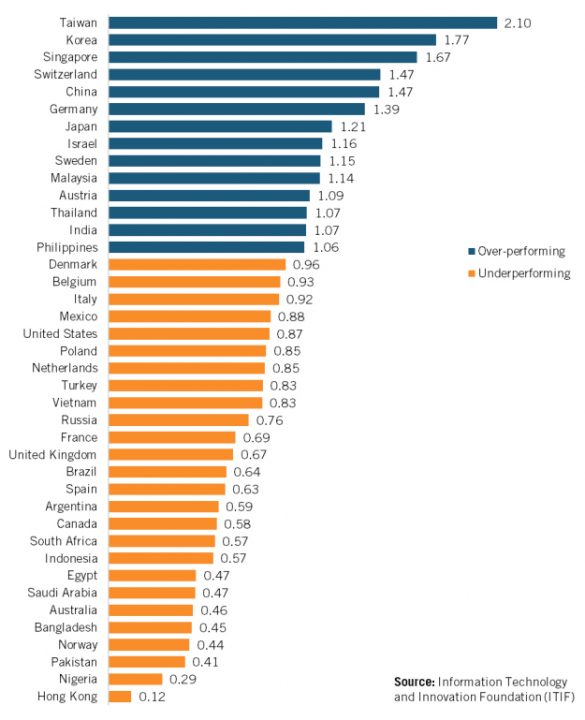WASHINGTON—Australia’s IT and information services industry is 10 percent stronger than the global average based on the size of its economy, according to a new report from the Information Technology and Innovation Foundation (ITIF), the leading think tank for science and technology policy.
But Australia’s other advanced and strategically important industries perform poorly, ITIF found in its Hamilton Index. From computers and electronics to machine equipment to motor vehicles, Australia’s advanced industries together were 54 percent weaker than the global average in 2020, the most recent year for which there is global data. This marked a steady, decades-long decline from 34 percent below average in 1995.
“A nation’s economic and national security increasingly depends on how well it performs in the global competition for market share in a select group of advanced industries,” said ITIF President Robert D. Atkinson, who led the new study. “Australia has consistently underperformed relative to the world, and relative to most other OECD nations.”
Using the latest data available from the Organization for Economic Cooperation and Development (OECD), ITIF’s Hamilton Index ranks 40 countries on their performance in 10 advanced and

strategically important industries: IT and information services; computers and electronics; pharmaceuticals and biotechnology; machine equipment; electrical equipment; motor vehicles; other transportation equipment; chemicals; fabricated metals; and basic metals.
To assess nations’ performance relative to the size of their economies, ITIF uses an analytical statistic known as a “location quotient” (LQ), which measures any region’s level of industrial specialization relative to a larger geographic unit—in this case, a nation relative to the rest of the world.
- Australia’s LQ in IT and information services was 1.10 in 2020, meaning it was 10 percent stronger than the global average based on the size of Australia’s economy—ranking 13th out of 40 countries studied. (See figure 2 below.)
- Australia’s LQ in all 10 advanced industries combined was just 0.46, meaning it was 54 percent weaker than the global average—ranking 35th out of the 40 countries studied. (See figure 1.)
- Australia’s worst-performing advanced industries in relative terms were electrical equipment and motor vehicles, where its LQs were just 0.19 and 0.16, respectively (or 19 percent and 16 percent of the global average). By that measure, Australia ranked 38th out of the 40 countries in the electrical equipment industry. It was 31st in the motor vehicles industry. (See figures 3 and 4.)
Along with the new Hamilton Index report, ITIF also released three interactive data visualization tools that are freely available for media, researchers, and the public to use as reference. They include:
- An industry-focused visualization tool showing how the 40 covered nations compare in gross output, relative output (LQ), and global market shares in each of the 10 covered industries plus the composite Hamilton Index.
- A country-focused visualization tool that breaks down how each of the 40 covered nations and other multinational groupings perform.
- A momentum visualization that weighs how nations’ and multinational groupings’ output and relative performance has changed over time.
“Australia has had the luxury of living off a China-fueled minerals boom, but it has neglected its advanced industries,” said Atkinson. “It is particularly striking that Australia’s policies toward IT and information services—the only advanced industry in which its performance is above average—is largely negative and out of sync with global best practices.”
# # #
[The Information Technology and Innovation Foundation (ITIF) is an independent, nonprofit, nonpartisan research and educational institute focusing on the intersection of technological innovation and public policy. Recognized by its peers in the think tank community as the global center of excellence for science and technology policy, ITIF’s mission is to formulate and promote policy solutions that accelerate innovation and boost productivity to spur growth, opportunity, and progress. Learn more at itif.org.]




